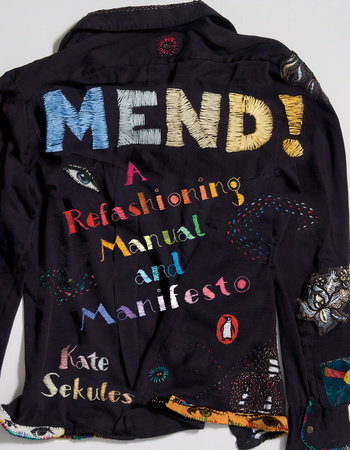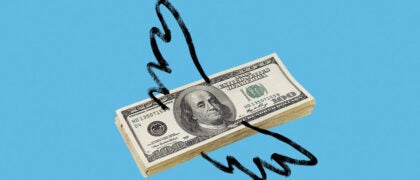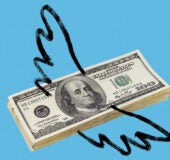Chapter One
What
I did not invent visible mending— nobody did. For goodness’ sake, it’s been around forever. There’s been so much mending, always, throughout history, it is bound to show occasionally. When fabrics were costly and clothes were handmade, we all preserved them for years, even generations; we had no choice. Until the nineteenth century fabrics were handwoven, too— that is, after seed was planted and grown (or flock tended), harvested, processed and spun, maybe all by the same person. The linen cloth (see page 2) came into my possession complete with handwritten provenance that tells how Marie Elizabeth Damier grew the flax in Tiège, near Baden, in the late eighteenth century and how Irene Marie Vedder, fresh off the boat on Ellis Island, sewed it in 1918. This still happens routinely in remote, poor, or destabilized regions, and many a back- to- the- land textile artisan these days is experimenting with the old ways by choice. Farm to table isn’t only a food term.
During the centuries when mending was not an aesthetic choice but a necessity, obvious repair was despised as a marker of poverty rather than valued and collected as artifact or fashion inspi-ration. These days, fashion is quite in love with imperfection and deconstruction and patch-ing. It has loved them at least since the 1970s, which happens to be when most home mending faded away. From the abomination that is mass-distressed denim at the low end, to the likes of Alessandro Michele’s embellished Gucci gear in haute, fashion likes the look, but it can only sell us brand- new perfect imperfection; it can never produce true mending. That is one of the best things about VM. Decorative repair is intensely personal and artisanal. It is done by hand, ideally by you, or at least someone you know. It is not outsourced to factories. And the skills are easy to acquire: visible mending is for everyone, includ-ing the nonvisual and the all- thumbs and the sewing novice. It’s experimental stitchery, mend-ing improv, fun with thread, arty and exuberant and colorful and silly. The only way to go wrong is to say, “I can’t.” It’s a craft, but of a modern cast, more art than Etsy. There are infinite ways to execute a VM, and there will never be another one like yours. And though you will never sew two mends the same, you will evolve a style of your own— it’s as inevitable as handwriting (if you can remember how to do that).Generally, visible mending encompasses a rebellion against the fashion status quo, a refusal to dress correctly, and thus a refusal to further line the pockets of a few over rich, white male, conscience- free titans of industry.Personally, I prefer VM militantly unpretty
and I often build in deliberate mess. If a mend ends up too professional, it simply looks shop-bought— and shop- bought usually means pro-duced in titanic factories in China, or, worse, in semiregulated probably dangerous smaller ones in Myanmar or Djibouti (or wherever labor is currently even cheaper than in notorious Ban-gladesh). But there is no rule that a VM must be a statement or a mess. It truly is for everyone, and you will even find hearts and flowers in these pages. Also plenty of rainbows; no uni-corns though. As the movement grows, there are menders of all stripes including stripes.No matter how you do it, VM comes with myriad unsuspected side benefits. So, to sum up the “What” of visible mending, see the list on the right. Menditation, which happens when you apply attention and mindfulness, or mendfulness, thus manipulating time, is my favorite, though the feeling of security that ensues when your elbow no longer protrudes from your old faithful sweater is not to be understated. I promise you will deeply under-stand and appreciate all ten by page 226.
Chapter Two
Why
Clearly, visible mending isn’t happening in a vacuum. Those who practice it tend to be evangelists for a world outside the fashion-industrial complex, advocates of civil disobedience, feminists, antiracists—in short, humanists. If you lavish time and attention on nonessential embellishment, adding extra layers to a task that wouldn’t occur to most people to attempt in the first place, you are not doing it just for eco- warrior cred— the more likely reason than frugality when replacing the thing costs less than breakfast— but as an opportunity. We personalize, extend the story, flag the beloved oldness, and render the item priceless— though not literally, because well- VM- ed garments can fetch a good resale price in my experience, and many modern menders who take commissions are quite unable to keep up with the demand.
You love clothes, or you wouldn’t be reading, but do you know where yours came from? I don’t mean Uniqlo or “stolen from my sister,” but their fundamental origins and what it all means. Clothes can be complicated creatures. They are not inert, but become unique with wear, even from the first time we take them for a ride, and then they gain in individual-ity with each outing. Our collections become extensions of us (“That dress is so you!”), combining in their own special, comforting ways and routinely performing magic tricks. One of my favorite T- shirts, for example, a 1990s Loomstate with angel wings on the back (and an extensive greasytee mend— see page 190— on the front) has an identical twin that rarely leaves the shelf: it inexplicably leaves me cold. Many of us own a results dress or lucky socks for sports, or a coat that’s gorgeous on the hanger but ghastly when worn. Clothes “change our view of the world and the world’s view of us,” wrote Virginia Woolf. The “Why” of visible mending is all about that personal nature of clothes— oh, let’s not mince words, the souls of clothes. And, while extending their lives, it also acknowledges their origins.The first thing the organization Fashion Revolution did when it formed, after more than a thousand garment workers were crushed to death in the Rana Plaza factory collapse, was ask the simple question: “Who made my clothes?” As well as a handy slogan, this question is a deceptively profound thought experiment. In my two decades as a food and travel journalist I reported on the dawning and spread of consciousness about what we put in our stomachs. It was not so long ago that terms such as farm to table, clean eating, locavore, and market driven were coined and we could no longer automatically detach the product from its origin.We need to do this with clothes.
The term fast fashion was first used in print by The New York Times in December 1989, evoking its food corollary to report on the new stores in town, including The Limited and Zara. I use the more sinister Big Fashion. Though there is a burgeoning slow fashion movement, the US fashion revolution was a bit muted at first. Partly this is because (a) much “eco- fashion” produc ed in re sponse to t he issue s of t he indu s-try is not tasty— it’s really expensive and just not sexy, and (b) nobody likes to be scolded.
It’s all too human to shy away from apparently insoluble problems. The Gordian knot of issues in the fashion system is simply too de-pressing. We glance at the horrifying story of some industry abuse— children employed by Nike, microfiber ocean pollution— then look down at our performance fiber leggings and the swoosh on our new sneakers, feel a stab of guilt, and head to the gym. Who can afford to dress correctly? Where do you even get those clothes? How can you tell what’s been made ethically? What difference does it make anyway? Just this little $12.99 sequined top.
Neither are you off the hook if you’re a designer dresser, not once you’ve heard the indus-try’s not- so- secret that most luxury- label clothes are produced in the exact same factories as their cheaper sisters, and those factories are trashing the planet about as much as your car is. It’s all enough to make you run the other way— straight to your phone for some comfort shopping. Fashion isn’t meant to make us feel guilty, confused, and angry. We need fashion to make us feel good.
A Disclaimer
I wrote this chapter in early 2019, when the fashion industry was already troubled. By No-vember, one State of Fashion report opened withthe words “Fashion leaders are not looking forward to 2020.” They were, it said, in “a state of high nervousness and uncertainty.” Then the pandemic hit. Now (early April 2020) I’m trying to future- proof a chapter about what’s wrong with fashion, when fashion may by now (your “now”) have already expired. It won’t have been a peaceful death. There was a lot of talk in 2019 from those nervous fashion leaders about becoming more “sustainable”— but they didn’t mean by the crash and burn method, where less is produced because few can afford it and fewer desire it, and therefore companies go under. Tragically, the kind of independent fashion leaders who truly do lead by design, creativity, and innovation are going to struggle even harder to survive, and the prognosis is . . .desperate. I’m hoping for miracles. Meanwhile, back in the fashion-industrial complex, nobody wanted to lose their ludicrous profits (detailed on page 15), but I’m guessing one of the better side effects of the pandemic will be that the entire world will begin functioning more like the global system it is, and that we can therefore regard this chapter as a snapshot of the dying days of late-stage capitalism and rampant overconsumption, and a warning to not go back there.
Copyright © 2020 by Kate Sekules. All rights reserved. No part of this excerpt may be reproduced or reprinted without permission in writing from the publisher.







